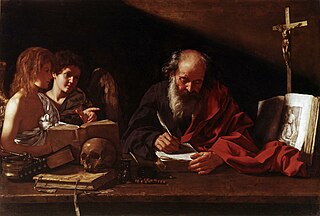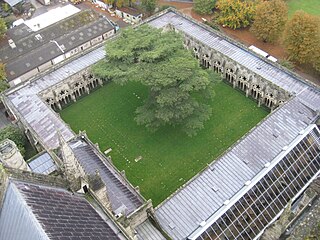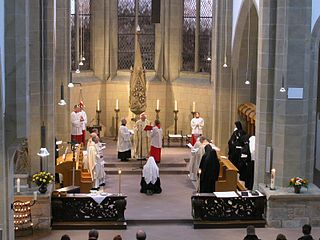Related Research Articles

An abbey is a type of monastery used by members of a religious order under the governance of an abbot or abbess. Abbeys provide a complex of buildings and land for religious activities, work, and housing of Christian monks and nuns.

Anointing of the sick, known also by other names such as unction, is a form of religious anointing or "unction" for the benefit of a sick person. It is practiced by many Christian churches and denominations.
Canon law is a set of ordinances and regulations made by ecclesiastical authority, for the government of a Christian organization or church and its members. It is the internal ecclesiastical law, or operational policy, governing the Catholic Church, the Eastern Orthodox and Oriental Orthodox churches, and the individual national churches within the Anglican Communion. The way that such church law is legislated, interpreted and at times adjudicated varies widely among these four bodies of churches. In all three traditions, a canon was originally a rule adopted by a church council; these canons formed the foundation of canon law.

The Patriarch of Alexandria is the archbishop of Alexandria, Egypt. Historically, this office has included the designation "pope".

A hermit, also known as an eremite or solitary, is a person who lives in seclusion. Eremitism plays a role in a variety of religions.

A cloister is a covered walk, open gallery, or open arcade running along the walls of buildings and forming a quadrangle or garth. The attachment of a cloister to a cathedral or church, commonly against a warm southern flank, usually indicates that it is part of a monastic foundation, "forming a continuous and solid architectural barrier... that effectively separates the world of the monks from that of the serfs and workmen, whose lives and works went forward outside and around the cloister."

Mary of Egypt was an Egyptian saint, highly venerated as a Desert Mother in the Eastern Orthodox and Coptic Churches. The Catholic Church commemorates her as a patron saint of penitents.

Religious vows are the public vows made by the members of religious communities pertaining to their conduct, practices, and views.

Consecrated life is a state of life in the Catholic Church lived by those faithful who are called to follow Jesus Christ in a more exacting way. It includes those in institutes of consecrated life, societies of apostolic life, as well as those living as hermits or consecrated virgins/widows.
An institute of consecrated life is an association of faithful in the Catholic Church erected by canon law whose members profess the evangelical counsels of chastity, poverty, and obedience by vows or other sacred bonds. They are defined in the 1983 Code of Canon Law under canons 573–730.
The Apostolic Church-Ordinance is an Oriental Orthodox Christian treatise which belongs to genre of the Church Orders. The work can be dated at the end of 3rd century CE. The provenience is usually regarded as Egypt, or perhaps Syria. The author is unknown.
Ecclesiastical letters are publications or announcements of the organs of Roman Catholic ecclesiastical authority, e.g. the synods, but more particularly of pope and bishops, addressed to the faithful in the form of letters.
An ordinance or ecclesiastical ordinance is a type of law, legal instrument, or by-law in the canon law of the Catholic Church, the Anglican Communion, and in Calvinism.
According to both Catholic and Anglican canon law, a cathedral chapter is a college of clerics (chapter) formed to advise a bishop and, in the case of a vacancy of the episcopal see in some countries, to govern the diocese during the vacancy. In the Roman Catholic Church their creation is the purview of the pope. They can be "numbered", in which case they are provided with a fixed "prebend", or "unnumbered", in which case the bishop indicates the number of canons according to the rents. These chapters are made up of canons and other officers, while in the Church of England chapters now include a number of lay appointees. In some Church of England cathedrals there are two such bodies, the lesser and greater chapters, which have different functions. The smaller body usually consists of the residentiary members and is included in the larger one.
Henry Tattam was a Church of England clergyman and Coptic scholar.

The 1983 Code of Canon Law, also called the Johanno-Pauline Code, is the "fundamental body of ecclesiastical laws for the Latin Church". It is the second and current comprehensive codification of canonical legislation for the Latin Church sui iuris of the Catholic Church. It was promulgated on 25 January 1983 by John Paul II and took legal effect on the First Sunday of Advent 1983. It replaced the 1917 Code of Canon Law which had been promulgated by Benedict XV on 27 May 1917.
A religious institute is a type of institute of consecrated life in the Catholic Church whose members take religious vows and lead a life in community with fellow members. Religious institutes are one of the two types of institutes of consecrated life; the other is that of the secular institute, where its members are "living in the world".
The ancient church orders form a genre of early Christian literature, ranging from 1st to 5th century, which has the purpose of offering authoritative "apostolic" prescriptions on matters of moral conduct, liturgy and Church organization. These texts are extremely important in the study of early liturgy and served as the basis for much ancient ecclesiastical legislation.
In the canon law of the Catholic Church, the computation of time, also translated as the reckoning of time, is the manner by which legally-specified periods of time are calculated according to the norm of the canons on the computation of time. The application of laws frequently involves a question of time: generally three months must elapse after their promulgation before they go into effect; some obligations have to be fulfilled within a certain number of days, or weeks, or months. Hence the need of the rules for the computation of time. With the Code of 1917 and the reformed Code of 1983, the legislator has formulated these rules with a clearness and precision that they never had before.
The philosophy, theology, and fundamental theory of Catholic canon law are the fields of philosophical, theological (ecclesiological), and legal scholarship which concern the place of canon law in the nature of the Catholic Church, both as a natural and as a supernatural entity. Philosophy and theology shape the concepts and self-understanding of canon law as the law of both a human organization and as a supernatural entity, since the Catholic Church believes that Jesus Christ instituted the church by direct divine command, while the fundamental theory of canon law is a meta-discipline of the "triple relationship between theology, philosophy, and canon law".
References
- 1 2 3 Herbermann, Charles, ed. (1913). . Catholic Encyclopedia . New York: Robert Appleton Company.